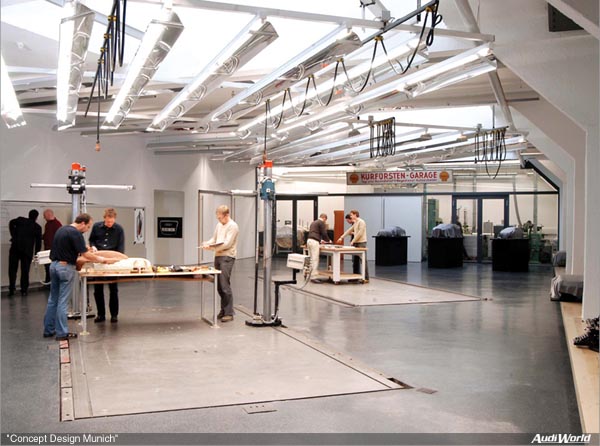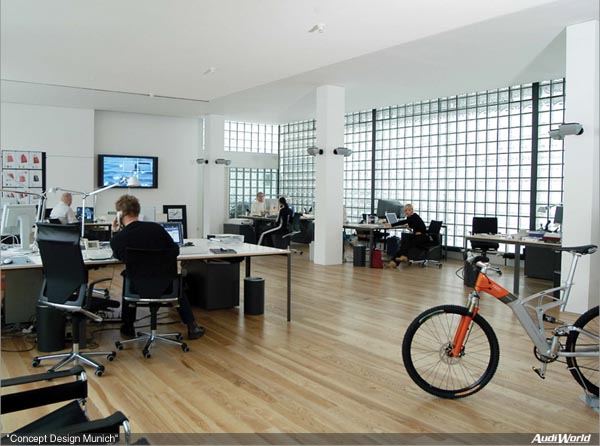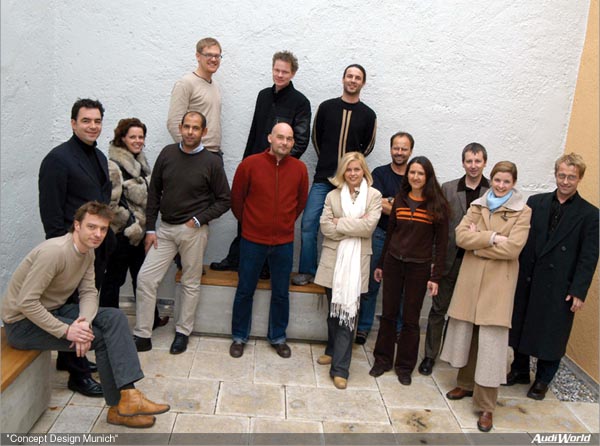Audi Brand Group: “Concept Design Munich” Opened

Who would imagine that a car manufacturer’s design studio would be found here? In a neighbourhood of elegant old residential buildings, street cafés, trendy bars, unusual fashion boutiques, hairdressing salons and oriental snack bars, the gateway to Kurfürstenstrasse No. 24 in the Munich district of Schwabing is not especially striking. One would little suspect that the Audi brand group has set up a think tank for automotive forward and lateral thinkers in this inner courtyard. “Vorsprung durch Technik” in a truly cosmopolitan environment. The former Audi Design Studio Munich had already been based at this former car workshop for 20 years. Over a period of six months, it was converted, extended and modernised before reopening as the “Concept Design Munich” facility of the Audi brand group. This pulsating urban environment is intended to foster visionary concepts that will shape the future of the Audi, SEAT and Lamborghini brands. For Walter Maria de’Silva, Head of Design for the Audi brand group, it is something else as well: “We want this studio to be an interdisciplinary platform for communication, not a closed community. We want the brands to enter into dialogue. We will be inviting creative people from all disciplines, trend experts, specialists from the fields of economics, technology and sociology, as well as opinion leaders and students, to discuss and work with them. One of our particular aims is to promote exchanges with universities from all over the world. This will help us to unlock even greater creative potential and find new perspectives, ideas and stances on the future of design.” All this within premises that the chief designer refers to with a wry smile as “my living room” – a place with an almost private atmosphere. The ochre-coloured building from the 1940s that houses this “living room” has had long-standing associations with cars. Before the arrival of Audi’s designers in 1983, this was the home of a neighbourhood car repair shop called “Kurfürstengarage Schwabing”. Klemens Rossnagel, Head of Concept Design Munich, elaborates: “After its transformation, various showcars such as the Audi Avus quattro, the Al2 and the Steppenwolf took shape here. The shape of the Audi RS 6 likewise originated at Kurfürstenstrasse 24.” A stairway with light-coloured wooden steps takes the visitor up to a second, somewhat larger conference room on the upper floor. At one end there is a very noticeable masonry wall, again equipped with large-format flat screens for presentations. Here again, a new approach has been adopted. The Munich designers have made a break with the classic paper presentation, and have now embraced the principle of multimedia presentations involving sound and images. “We are endeavouring to introduce an emotional component into even these processes,” explains the studio’s head. In keeping with the character of a design studio, everything in the Schwabing facility is very stylish but radiates an agreeable atmosphere thanks to the use of warm, light colours and materials and the compact size of the premises. The studio encloses a total effective floor area of around 800 square metres. The out-and-out character of a workshop can be experienced in the ground-floor modelling hall, which can only be accessed via an electronically protected door. Beneath its “ceiling of light” there is space for designers and up to 15 (mostly self-employed) modellers to work on two 1:1 vehicle models or several 1:4 models. Here, too, there is an exquisite contrast between “old” and “new”. Alongside futuristic vehicle concepts, there are an antiquated Wanderer typewriter and a time clock on display. Rossnagel: “Our task is to think well into the future, without losing touch with our past.” Providing a spatial link between this workshop and the designers’ computer workstations and also acting as a meeting-place is “la cucina”, a communication zone in which people can discuss concepts and ideas over a meal next to a classic DKW racing bike. One door on from this is a large, light-filled room made from glass modules, where the designers are at home. The former store room dating from the 1960s was likewise rented as part of the studio extension project and completely revamped to give it a new lease of life. Up to 20 creative personnel now work here, in a studio with the atmosphere of a penthouse. Visionary concepts for the brand group take shape on computer screens and sketch pads here. “We are able to work in a lively, urbane environment here, free from the pressures of production-vehicle development. We work in part on behalf of one particular brand, as the brand group’s service provider, and in part on our own development projects. That’s precisely what our task is: to question established concepts, produce bold developments that may perfectly well deviate from the brief we have from Group Headquarters; breathe new ideas into the group as a result; nurture creative potential; set out on a journey well into the future – we are expressly intended to be using forward and lateral thinking,” explains Rossnagel.
The Munich studio’s task is therefore not to refine the appearance of forthcoming production models. Rather, the designers are focusing on what an Audi of the next generation but one might look like. This involves the creative experts from Audi Design in Ingolstadt and the Audi Design Studio in California maintaining a dialogue with the SEAT designers in Martorell and Sitges (Spain) or, in future, the Lamborghini designers in Sant’Agata (Italy). This is a forum for ideas to inspire all contributors, as a central element of the Audi brand group’s design strategy. The image of the various brands is also being finely honed here. Because the work being performed in Munich does not focus solely on the concept design of future vehicles, but also on product design, which includes the styling of lifestyle articles. The range of fashion and sports articles that are created at the brand group’s design studio extends from watches, tie pins and key rings, through textiles of all kinds, to mountain bikes. There are five designers deployed in this area alone. Ulrike Dust, who is responsible for lifestyle articles at quattro GmbH for the Audi brand group, adds: “We are developing an interdisciplinary process to stimulate and enrich our automotive design activities. Product design gives the designers further scope to develop and significant input as a result of working in a wide variety of product realms beyond the automotive sector. Designers with qualifications in highly specialised areas, such as fashion design, are also working at the Munich studio. This paves the way for creative exchanges that benefit all concerned. We moreover want to familiarise our customers with the design quality of the Audi brand group and the brand universes of the individual brands in other areas, too.” The presence of guests provides an extra breath of fresh air. Studio chief Rossnagel explains: “Here in Schwabing we are permanently playing host to three students on placements from international universities.” Colleagues from the Design, Technology and Marketing Departments of the Audi, SEAT and Lamborghini brands can likewise come to Munich for a time to revitalise their creativity, come up with fresh ideas and contribute their own input towards future projects. There are currently designers from five different countries (Germany, Spain, Italy, Greece and France) at the Schwabing studio, ensuring that creative potential transcending national boundaries is exploited. “Each brand is striving to put across its own messages and values. We want to encourage this process. Here, we are able to explore new approaches in design,” adds the studio boss. In order to realise this objective, the Schwabing-based designers enjoy more freedom than their colleagues. “When exercised responsibly, this freedom is a valuable asset,” adds Rossnagel. Why should the designers not choose to work in the English Garden with their sketch pad or laptop, for instance? The best ideas often come spontaneously, not necessarily while the designer is at his or her desk, and are prompted by simply being where the action is.
The design centres of the Audi brand group Audi brand group Design Audi Design Seat Design Lamborghini Design “Concept Design Munich” The formal idiom of the group A clear architecture has been laid down for each individual brand within the Audi brand group. The objective is to accentuate the distinctive character of each brand and its models, rather than allowing them to become diluted. All vehicles within the brand group must radiate the common theme of sportiness and emotion, but in fundamentally different ways. Vehicles from Audi, SEAT and Lamborghini should in future bear no closer resemblance to each other than a square, circle and triangle do. Walter Maria de’Silva, Head of Design for the Audi brand group, illustrates his philosophy by reference to the simple common denominator of basic geometrical shapes. |


